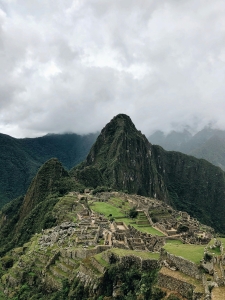The ancient art of irrigating in tough terrain
WATER HISTORY WEDNESDAY | EDITION 05
Not every civilisation of the ancient world had a river as their main source of water. Many accessed groundwater, but perhaps the most difficult water supply to manage was in mountainous settlements.
In ancient civilisations, mountainous regions faced a different set of challenges. In mountainous landscapes, it was important to slow water down, this is because water travelling downhill at high speeds increased erosion. Not only would this impact the landscape itself, but any infrastructure built to capture water would be challenged and likely require frequent maintenance.
Mountains were a tough area to navigate and required some different and creative thinking to ensure these regions remained survivable.
One of the strategies developed to mitigate this issue was terracing. Terraces were structures that started at a height and descended in a meandering path. Terraces were usually staggered with levels, a flow path like that prevents water from flowing easily and quickly over a surface, instead directing to follow a path that would hold up its descent as much as possible.
Terraced fields first appeared on hillsides as a form of fortification in prehistoric times, but later became a form of agricultural production that appears on mountains all over the world.
Terraces are a monumental example of early engineering development and especially impressive with the way the structures were created. Now, several terraces are listed on the World Cultural Heritage list by UNESCO including the Honghe Hani and Yuangyan terraces in China, the Ifugao rice terraces in the Philippines and the Lavaux vineyard terraces in Switzerland.
 Arguably, the most famous of the mountain terraces is the Incan terraces at Machu Picchu. These agricultural terraces were part of an Incan royal retreat and created as fields for crops. The terraces are formed by stone retaining walls and contain thick topsoil. Although investigations suggest that there was no evidence these terraces were irrigated, there was evidence that agricultural drainage water, along with basin subsurface runoff, was captured and used for several fountains located downhill. Not only used for farming, these terraces provided protection from runoff down the mountain and helped to prevent hillside erosion.
Arguably, the most famous of the mountain terraces is the Incan terraces at Machu Picchu. These agricultural terraces were part of an Incan royal retreat and created as fields for crops. The terraces are formed by stone retaining walls and contain thick topsoil. Although investigations suggest that there was no evidence these terraces were irrigated, there was evidence that agricultural drainage water, along with basin subsurface runoff, was captured and used for several fountains located downhill. Not only used for farming, these terraces provided protection from runoff down the mountain and helped to prevent hillside erosion.
Terracing is the result of a massive human effort, turning steep mountain slopes into oversized ‘stairsteps’ of narrow fields held up by a retaining wall. Each step of the terrace is irrigated by water transported down the mountainside from springs, rivers, or reservoirs, using a complex network of canals, sluices, and pipes. The terraces allow the hillside to be cultivated with minimal soil erosion, serving to keep irrigation water on the fields.
The Rice Terraces of the Philippine Cordilleras is a brilliant example of an evolved and successful civilisation in a mountainous landscape.
The Philippine Cordillera Mountain range is located on the northern island of Luzon, Philippine archipelago. The Banaue rice terraces are a system of irrigated rice terraces in the Luzon mountains. These terraces were created 2,000-6,000 years ago by the Ifugao people and although they are located in several villages, they are collectively known as the Banaue rice terraces. The Banaue Rice Terraces begin at the base of the mountain range and extend upwards several thousand feet in a staggered, step-like fashion.
The rice terraces were largely built by hand with hand tools and animal power and were specifically constructed to receive water from the mountain’s rainforest above for irrigation. The Ifugao people irrigated the fields by the mountain streams and springs tapped and channelled into canals that run downhill through the rice terraces.
This feat requires intense cooperation among the Ifugao people, as a result, a significant portion of the terraces has deteriorated. Having been listed as a World Heritage site in 1995, they have now been added to UNESCO’s list of World Heritage in Danger.




